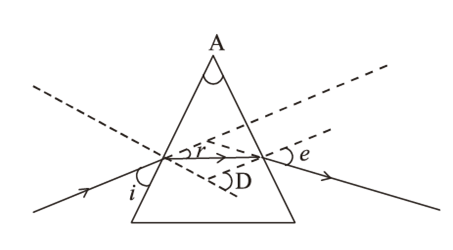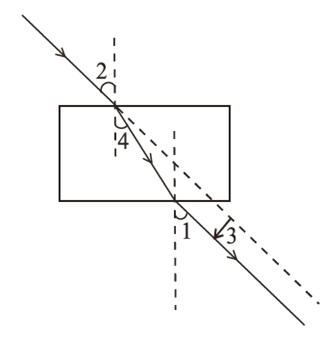Light - Reflection and Refraction
Analyse the following observation table showing a variation of image distance (v) with object distance (u) in the case of a convex lens and answer the questions that follow, without doing any calculations:
| S. No. |
Object distance |
Image distance |
| 1 | -90 | +18 |
| 2 | -60 | +20 |
| 3 | -30 | +30 |
| 4 | -20 | +60 |
| 5 | -18 | 90 |
| 6 | -10 | 100 |
(a) What is the focal length of the convex lens ? Give reason in support of your answer.
(b) Write the serial number of that observation which is not correct.How did you arrive at this conclusion?
(c) Take an appropriate scale to draw a ray diagram for the observation at S. No. 4 and find the approximate value of magnification.
(a) From serial number 3 we can say that the radius of curvature of the lens is 30 cm because when an object is placed at the centre of curvature of a convex lens its image is formed on the other side of the lens at the same distance from the lens. And, we also know that focal length is half of the radius of curvature. Thus, the focal length of the lens is + 15 cm.
(b) Serial number 6 is not correct as the object distance is between focus and pole so for such cases the image formed is always virtual but in this case, a real image is forming as the image distance is positive.
(c) Approximate value magnification for object distance - 20 cm and image distance + 60 cm is 3.
Sponsor Area
Some More Questions From Light - Reflection and Refraction Chapter
To construct a ray diagram we use two rays which are so chosen that it is easy to know their directions after reflection from the mirror. List two such rays and state the path of these rays after reflection in case of concave mirrors. Use these two rays and draw ray diagram to locate the image of an object placed between pole and focus of a concave mirror.
A concave mirror produces three times magnified image on a screen. If the object is placed 20 cm in front of the mirror, how far is the screen from the object?
In the following diagram the correctly marked angles are:
The correct sequencing of the angle of incidence, the angle of emergence, the angle of refraction and lateral displacement shown in the following diagram by digits 1, 2, 3 and 4 is:
A student places a candle flame at a distance of about 60 cm from a convex lens of focal length 10 cm and focuses the image of the flame on a screen. After that, he gradually moves the flame towards the lens and each time focuses the image on the screen.
(a) In which direction-toward or away from the lens, does he move the screen to focus the image?
(b) How does the size of the image change?
(c) How does the intensity of the image change as the flame moves towards the lens?
(d) Approximately for what distance between the flame and the lens, the image formed on the screen is inverted and of the same size?
If the image formed by a spherical mirror for all positions of the object placed in front of it is always erect and diminished, what type of mirror is it? Draw a labelled ray diagram to support your answer.
Mock Test Series
Sponsor Area
NCERT Book Store
NCERT Sample Papers
Sponsor Area